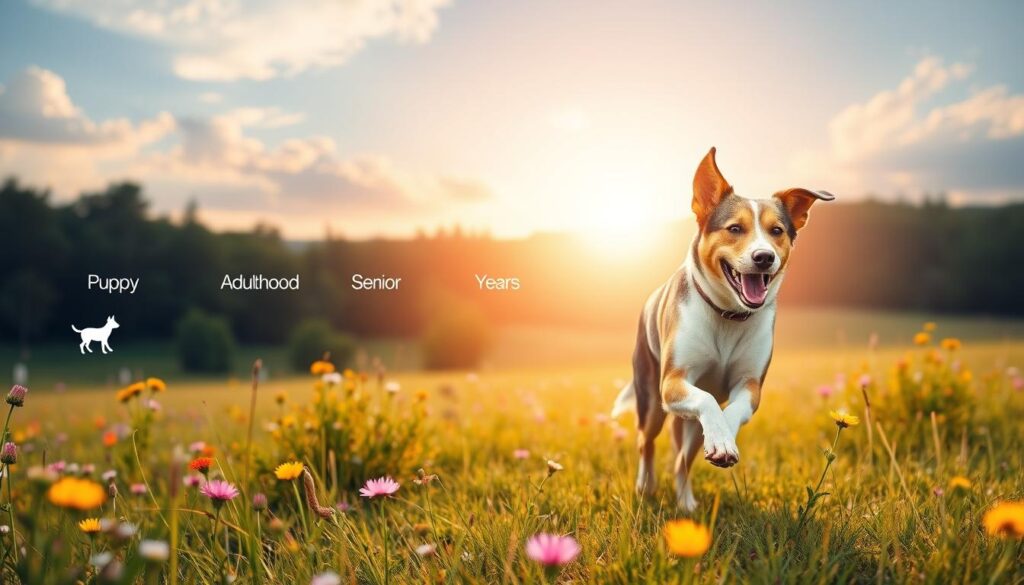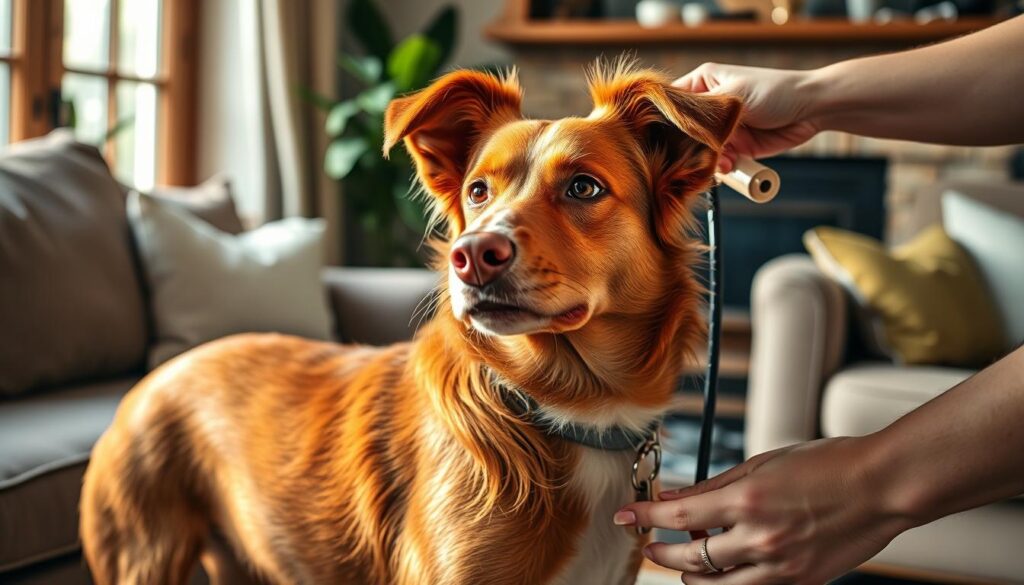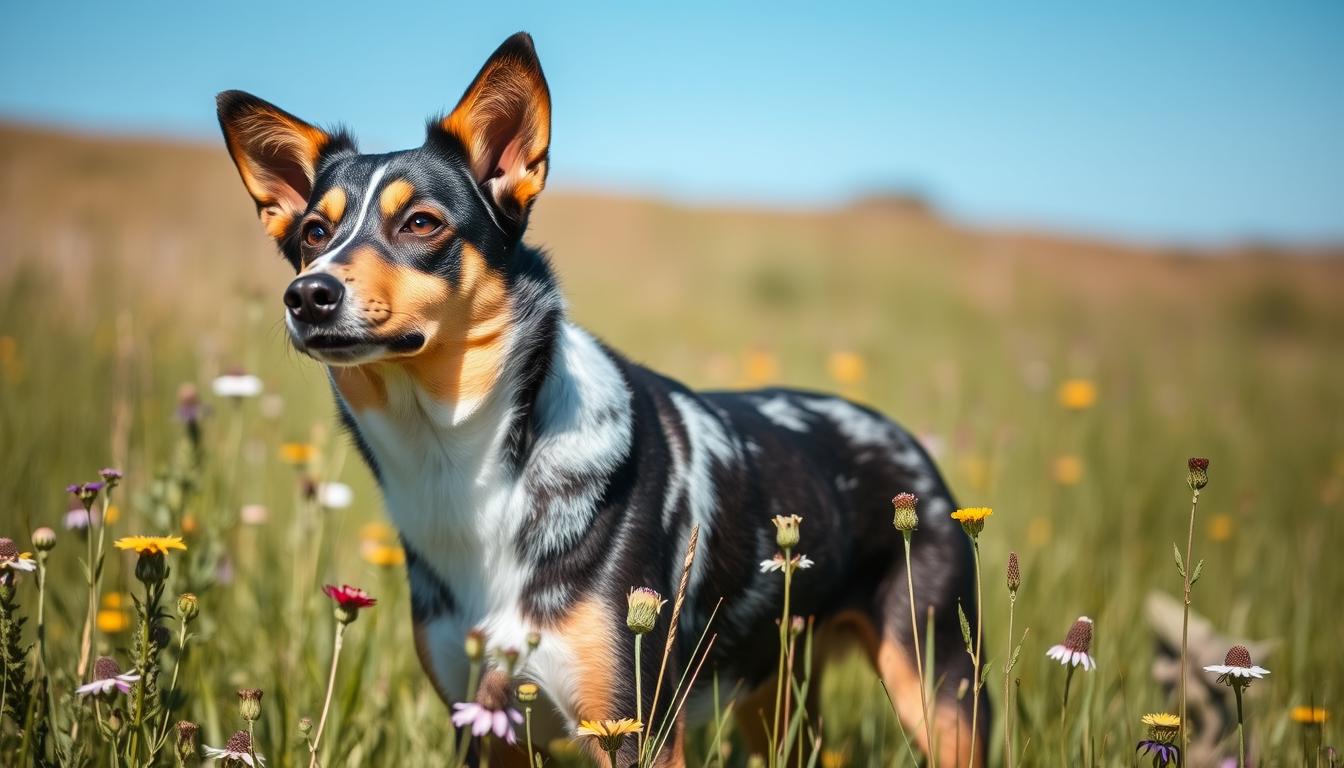If you own a Heeler dog or are thinking of getting one, you’re in for a treat. The Heeler, also known as the Australian Cattle Dog, is a unique breed. It has a rich history, distinctive looks, and a lively personality. In this guide, we’ll cover everything you need to know about caring for your Heeler dog.
Key Takeaways
- The Heeler, or Australian Cattle Dog, is a herding breed with a strong work ethic and intelligence.
- Heelers are known for their distinctive red or blue coats and their ability to work tirelessly alongside their human partners.
- Proper training and socialization are essential for Heelers, as they are highly energetic and require mental and physical stimulation.
- Heelers are generally healthy dogs, but they can be prone to certain medical conditions that require vigilant monitoring and care.
- Heeler mixes, such as the Blue Heeler Australian Shepherd and Border Collie Heeler, offer unique blends of characteristics that may appeal to different owners.
Understanding the Heeler Dog Breed History and Origins
The Australian cattle dog, also known as the red heeler or blue heeler, has a rich history. It comes from the Australian outback. These dogs have helped a lot in Australia’s farming, becoming loyal and hardworking friends.
Australian Heritage and Development
The Australian cattle dog started in the early 19th century. European settlers in Australia needed a good herding dog. They mixed breeds like the Dingo, Collie, and Dalmatian to make a smart, tough dog for the tough terrain.
Evolution of Working Capabilities
As the Australian cattle dog breed grew, so did its skills. These dogs were known for their sharp instincts, long work hours, and teamwork with humans. They helped drive cattle and manage herds, becoming key to Australian farmers and ranchers.
Recognition and Breed Standards
The Australian cattle dog is now well-known and respected. In 1903, it was recognized by the Australian National Kennel Council. Today, it’s loved for its work, loyalty, smarts, and as a family pet.
Physical Characteristics of Red and Blue Heelers
The Australian Cattle Dog, also known as the Red Heeler or Blue Heeler, is a distinct breed. They are known for their robust physical features. These working dogs have a unique size, coat types, and color variations.
Red Heelers and Blue Heelers have a similar size and build. They are medium-sized and muscular. They stand between 16 and 20 inches tall and weigh 35 to 50 pounds. The main difference is their coat color.
- Red Heelers have a dense, short coat that ranges from deep red to reddish-brown.
- Blue Heelers have a blue-gray coat with black or white markings.
Red Heelers do not get their signature coat color until around 18 months of age. As puppies, they have a mix of red, white, and black hairs. Over time, the red color becomes more prominent.
| Characteristic | Red Heeler | Blue Heeler |
|---|---|---|
| Coat Color | Deep red to reddish-brown | Blue-gray with black or white markings |
| Coat Type | Dense, short | Dense, short |
| Height | 16-20 inches | 16-20 inches |
| Weight | 35-50 pounds | 35-50 pounds |
Both Red and Blue Heelers have a distinctive double coat. The undercoat is soft and insulating, while the outer layer is coarser and protective. This coat helps them thrive in various climates, making them perfect for outdoor work and adventures.
“The Australian Cattle Dog embodies the rugged versatility of its breed, showcasing unique physical traits that distinguish it from other canine companions.”
Temperament and Personality Traits of Heeler Dogs
The Australian heeler dog, also known as the Australian cattle dog, has a rich history. It’s perfect for active lifestyles. These dogs are smart and love to work, solving problems and staying focused on their tasks.
Intelligence and Working Drive
Heeler dogs are very smart and easy to train. They love to learn and do well in many activities. With the right training, they can be great at herding, search and rescue, or even as service animals.
Social Behavior and Family Dynamics
Heelers bond strongly with their families. They are loyal, loving, and protective. But, they might herd or nip at kids due to their high energy. Early training helps them be gentle with children.
Common Behavioral Patterns
Heeler dogs have some common behaviors. They chase and herd, need lots of exercise and mental stimulation, and can get anxious when left alone. Proper care and training can keep them happy and well-adjusted.
The Australian cattle dog lifespan is 12 to 16 years. This means owners can enjoy their company for a long time.
Training Requirements and Best Practices
Heeler dogs, like the Australian Cattle Dog Blue Heeler Mix, are smart and easy to train. They love solving problems and pleasing their owners. This makes them great friends and working dogs.
Start training your heeler early and be consistent. They need clear rules and a routine. Use treats and praise to teach them good habits and strengthen your bond.
- Focus on basic commands like sit, stay, come, and heel. Heelers learn fast with regular practice.
- Keep them mentally active with puzzle toys, agility, and brain games. This stops boredom and bad behavior.
- Teach them to be friendly with strangers. Introduce them to new people, animals, and places in a safe way.
- Think about special training like herding or therapy work. Heelers do well in these roles.
Training a heeler mix needs patience and consistency. With the right method, you’ll enjoy many happy years together.
| Training Approach | Recommended Techniques |
|---|---|
| Obedience Training |
|
| Mental Stimulation |
|
| Socialization |
|
| Specialized Training |
|
“With their intelligence and eagerness to learn, heeler dogs are a joy to train. The key is to be patient, consistent, and focus on positive reinforcement techniques.”
Exercise Needs and Activity Recommendations
Heeler dogs, like the heeler mix and blue heeler mix, are full of energy and love to work. They need lots of physical and mental play to stay happy and healthy. It’s key to know how much exercise they need and keep them busy.
Physical Exercise Requirements
Heelers are very active and need lots of physical activity. Without enough stimulation, they can become bored and destructive. Aim for at least 60 minutes of exercise a day, but they might want more.
Activities like long walks, jogging, hiking, and playing in a safe area are great. They help meet their physical needs.
Mental Stimulation Activities
Heeler dogs also need lots of mental challenges to stay sharp. Activities like obedience training, agility, nose work, and interactive games are perfect. They keep their minds active and prevent boredom.
Puzzle toys and food-dispensing toys are also great for mental stimulation. They provide fun challenges for their brains.
Work and Sports Opportunities
Heeler dogs are great at dog sports and work because of their herding instincts. They do well in herding trials, flyball, agility, and even as service or therapy dogs. These activities give them a sense of purpose and keep them mentally and physically active.
Finding the right balance between physical and mental exercise is important for your heeler mix or blue heeler mix. A well-rounded exercise plan tailored to their needs keeps them happy, healthy, and well-adjusted.
Health Considerations and Common Medical Issues
Heeler dogs are loved by many, but they face unique health challenges. Knowing about these issues helps you care for your Australian cattle dog or red heeler better.
Heelers typically live 12 to 15 years, which is impressive for such active dogs. Their australian cattle dog lifespan can vary based on diet, exercise, and genetics. Regular vet visits are key to keeping them healthy and spotting problems early.
The why does my red heeler have black spots on their coat is often genetic. But, some Heelers might be more likely to get hip and elbow dysplasia, progressive retinal atrophy, or von Willebrand’s disease, a blood clotting issue.
| Common Health Concerns for Heelers | Prevalence | Symptoms |
|---|---|---|
| Hip and Elbow Dysplasia | Moderate | Stiffness, lameness, pain |
| Progressive Retinal Atrophy | Low | Vision loss, night blindness |
| Von Willebrand’s Disease | Low | Excessive bleeding, bruising |
Good breeding and early vet screenings can reduce health risks. By understanding these challenges and caring for your Heeler, you can ensure a long, happy life together.

Popular Heeler Mix Breeds and Their Characteristics
There are many mixed-breed dogs that mix the Australian Cattle Dog, also known as the Blue Heeler. These dogs combine the Heeler’s smarts, herding skills, and strong build with traits from other breeds. This creates pets with unique personalities and abilities.
Blue Heeler Australian Shepherd Mix Traits
The blue heeler australian shepherd mix has the high energy and versatility of the Australian Shepherd. It also has the Heeler’s strong work ethic and protective nature. These dogs love to herd, bond deeply with their families, and need lots of exercise to be happy.
Border Collie Heeler Combinations
When you mix the australian cattle dog blue heeler with a Border Collie, you get a very smart and active dog. They have strong herding instincts and need lots of training and activities. This could be agility, flyball, or herding sheep.
Other Common Heeler Crosses
- Heeler Labrador Retriever: A friendly, versatile companion with the Heeler’s herding drive and the Labrador’s affectionate nature.
- Heeler German Shepherd: Blending the Heeler’s protectiveness with the German Shepherd’s loyalty and trainability.
- Heeler Husky: An energetic, adventurous mix with the Heeler’s intelligence and the Husky’s wanderlust.
Heeler mixes often have a strong work ethic, intelligence, and loyalty to their families. They are great for active homes looking for a hardworking and loving pet.
Grooming and Maintenance Requirements
Red heelers and blue heelers are energetic herding dogs. They need special grooming to keep their double coats looking good. Knowing how to groom them right will make them look and feel great.
Coat Care: Heeler dogs have a medium-length, double-layered coat. They need regular brushing to avoid mats and spread natural oils. Brush them a few times a week with a slicker brush or deshedding tool. This keeps their coat neat and tidy.
Bathing: Blue and red Heelers only need baths every 6-8 weeks. Use a mild, dog-safe shampoo. Don’t bathe them too often, as it can take away their coat’s oils. Dry them well after baths to avoid skin problems.
- Trim nails regularly to prevent cracking and discomfort
- Brush teeth 2-3 times per week to maintain dental health
- Check and clean ears monthly to prevent infection
Shedding: Heelers shed a lot during seasonal changes. Brush them more often during these times to reduce fur around your home. Regular grooming helps manage shedding and keeps their coat in top shape.

“Consistent, gentle grooming is key to keeping your Heeler’s coat healthy and tangle-free.”
By following these grooming tips, your red or blue Heeler will look and feel their best. Taking care of their unique coats is important for their health and happiness.
Nutrition and Dietary Guidelines for Your Heeler
Proper nutrition is key for your heeler dog or australian cattle dog. Heelers are active and need the right food to stay healthy. This includes enough energy, muscle growth, and overall health.
Age-Specific Dietary Needs
Heelers have different nutritional needs at different ages. Puppies need a lot of nutrients for fast growth. Senior Heelers need food that helps keep their weight and joints healthy.
Food Recommendations and Portions
Choose high-quality, protein-rich food for your Heeler. The right amount depends on their age, size, and how active they are. Always check with your vet to find the perfect portion size.
| Heeler Puppy | Adult Heeler | Senior Heeler |
|---|---|---|
| Nutrient-dense puppy food, 3-4 meals per day | High-quality adult dog food, 2 meals per day | Senior-specific formula, 2 smaller meals per day |
Dietary Restrictions and Supplements
Some Heelers might need special diets, like grain-free or low-fat. Your vet might suggest supplements for joint health or probiotics. This is to meet your Heeler’s specific needs.
Knowing what your heeler dog needs nutritionally helps them stay healthy and happy. It ensures they get the balanced diet they need to thrive.
Conclusion
The Heeler dog, also known as the Australian Cattle Dog or Blue/Red Heeler, is truly special. They are smart, full of energy, and very loyal. These traits make them great for active families who can keep up with them.
Whether you like the Blue Heeler’s look or the Red Heeler’s warm colors, they are amazing pets. They have strong herding instincts and are very devoted. This makes them great for farms or city homes.
If you’re thinking about getting a Heeler, remember they need lots of socialization, training, and exercise. With the right care, they’ll be a lifelong friend. Get ready for an exciting journey with this incredible breed.

